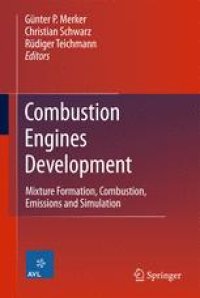
Ebook: Combustion Engines Development: Mixture Formation, Combustion, Emissions and Simulation
- Tags: Automotive Engineering, Engineering Thermodynamics Heat and Mass Transfer, Operating Procedures Materials Treatment, Energy Technology, Classical Continuum Physics
- Year: 2012
- Publisher: Springer-Verlag Berlin Heidelberg
- Edition: 1
- Language: English
- pdf
Combustion Engines Development nowadays is based on simulation, not only of the transient reaction of vehicles or of the complete driveshaft, but also of the highly unsteady processes in the carburation process and the combustion chamber of an engine. Different physical and chemical approaches are described to show the potentials and limits of the models used for simulation.
In the development of engines and vehicles it is nowadays standard practice to use commercially available computing programmes for simulation, not only of the transient reaction of vehicles or of the complete driveshaft, but also of the highly unsteady processes in the combustion chamber of an engine. Normally the source code is not available for these computing programmes and it takes too much time to study the respective specifications, so the users often do not have sufficient knowledge about the physical and chemical contents of the approaches that the programmes are based on. We have often been faced with this fact in talks to employees or in discussions during the presentation of results of simulation. Therefore it is our aim to point out different physical and chemical approaches and to show the possibilities and limits of the models used.
In the development of engines and vehicles it is nowadays standard practice to use commercially available computing programmes for simulation, not only of the transient reaction of vehicles or of the complete driveshaft, but also of the highly unsteady processes in the combustion chamber of an engine. Normally the source code is not available for these computing programmes and it takes too much time to study the respective specifications, so the users often do not have sufficient knowledge about the physical and chemical contents of the approaches that the programmes are based on. We have often been faced with this fact in talks to employees or in discussions during the presentation of results of simulation. Therefore it is our aim to point out different physical and chemical approaches and to show the possibilities and limits of the models used.
Content:
Front Matter....Pages i-xxv
Front Matter....Pages 1-1
Introduction....Pages 3-8
Reciprocating Engines....Pages 9-37
Combustion Diagnostics....Pages 39-117
Engine Combustion....Pages 119-168
Reaction Kinetics....Pages 169-191
Pollutant Formation....Pages 193-223
Front Matter....Pages 225-225
Calculation of the Real Working Process....Pages 227-308
Charging of Internal Combustion Engines....Pages 309-362
Exhaust Aftertreatment....Pages 363-384
Front Matter....Pages 385-385
Total System Analysis....Pages 387-414
Phenomenological Combustion Models....Pages 415-441
Three-Dimensional Flow Fields....Pages 443-482
Simulation of Injection Processes....Pages 483-535
Simulation of Combustion....Pages 537-584
3D Supercharging Simulations....Pages 585-599
Back Matter....Pages 601-642
In the development of engines and vehicles it is nowadays standard practice to use commercially available computing programmes for simulation, not only of the transient reaction of vehicles or of the complete driveshaft, but also of the highly unsteady processes in the combustion chamber of an engine. Normally the source code is not available for these computing programmes and it takes too much time to study the respective specifications, so the users often do not have sufficient knowledge about the physical and chemical contents of the approaches that the programmes are based on. We have often been faced with this fact in talks to employees or in discussions during the presentation of results of simulation. Therefore it is our aim to point out different physical and chemical approaches and to show the possibilities and limits of the models used.
Content:
Front Matter....Pages i-xxv
Front Matter....Pages 1-1
Introduction....Pages 3-8
Reciprocating Engines....Pages 9-37
Combustion Diagnostics....Pages 39-117
Engine Combustion....Pages 119-168
Reaction Kinetics....Pages 169-191
Pollutant Formation....Pages 193-223
Front Matter....Pages 225-225
Calculation of the Real Working Process....Pages 227-308
Charging of Internal Combustion Engines....Pages 309-362
Exhaust Aftertreatment....Pages 363-384
Front Matter....Pages 385-385
Total System Analysis....Pages 387-414
Phenomenological Combustion Models....Pages 415-441
Three-Dimensional Flow Fields....Pages 443-482
Simulation of Injection Processes....Pages 483-535
Simulation of Combustion....Pages 537-584
3D Supercharging Simulations....Pages 585-599
Back Matter....Pages 601-642
....
Download the book Combustion Engines Development: Mixture Formation, Combustion, Emissions and Simulation for free or read online
Continue reading on any device:

Last viewed books
Related books
{related-news}
Comments (0)